A History of Football Kit Design in England and Scotland
(6) The Swinging Sixties 1960-1969
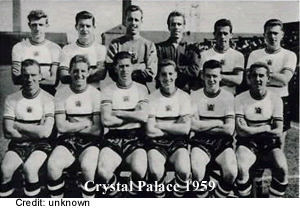 In April 1959, Crystal Palace turned out in new white shirts with crew necks trimmed in claret and light blue as well as a light blue horizontal band edged in claret. This would not be the last time that the team would wear an eye-catching and original strip. Although crew necks had appeared in the past this was the first time they had appeared on a modern shirt.
In April 1959, Crystal Palace turned out in new white shirts with crew necks trimmed in claret and light blue as well as a light blue horizontal band edged in claret. This would not be the last time that the team would wear an eye-catching and original strip. Although crew necks had appeared in the past this was the first time they had appeared on a modern shirt. 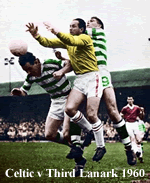 Within a few years they would become the standard.
Within a few years they would become the standard.
In Scotland, Celtic finally complied with the requirement to number their players, which must have been a great boon to spectators and commentators alike. Bob Kelly, the club chairman, insisted that these be worn on the front and back of the players' shorts so as not to besmirch their iconic hoops.
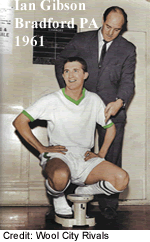 Beginning around 1962, crew necks started to replace V-necks. Shirts became
ever tighter, shorts became very short indeed and stockings were lightweight. Long sleeves returned to fashion and were generally worn as they were designed rather than being rolled up to the elbow, as had been the usual practice until the introduction of the Continental kits in 1955.
Beginning around 1962, crew necks started to replace V-necks. Shirts became
ever tighter, shorts became very short indeed and stockings were lightweight. Long sleeves returned to fashion and were generally worn as they were designed rather than being rolled up to the elbow, as had been the usual practice until the introduction of the Continental kits in 1955.
It might be supposed that technical advances in textile manufacture
and dye technology would have resulted in greater innovation in kit design.
It is true that for the first time shorts were available in a full range of colours but otherwise the trend 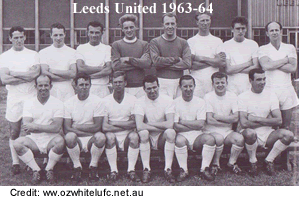 was towards the bland. The Sixties was a period when tradition was unpopular
and sleek, simplified design in everything from furniture to fashion was the
norm. Plain kits looked better under floodlights, which had now been installed
by every team in the Football League and Scottish League, allowing mid-week games to be played at night. Floodlighting made white kits stand out particularly well and there was a vogue for playing in all-white. Coventry started the trend in 1959 and during the following decade Tranmere, Bradford PA, Exeter, Brighton, Crystal Palace, Scunthorpe, Walsall, York, Doncaster, Port Vale and, most famously of all, Leeds United all dropped their traditional kits for white shirts and shorts. (The trend in Scotland was similar, with Dundee United, ES Clydebank, Morton and Stirling Albion all adopting white strips in this period.) Often a team's traditional colours were preserved in
was towards the bland. The Sixties was a period when tradition was unpopular
and sleek, simplified design in everything from furniture to fashion was the
norm. Plain kits looked better under floodlights, which had now been installed
by every team in the Football League and Scottish League, allowing mid-week games to be played at night. Floodlighting made white kits stand out particularly well and there was a vogue for playing in all-white. Coventry started the trend in 1959 and during the following decade Tranmere, Bradford PA, Exeter, Brighton, Crystal Palace, Scunthorpe, Walsall, York, Doncaster, Port Vale and, most famously of all, Leeds United all dropped their traditional kits for white shirts and shorts. (The trend in Scotland was similar, with Dundee United, ES Clydebank, Morton and Stirling Albion all adopting white strips in this period.) Often a team's traditional colours were preserved in 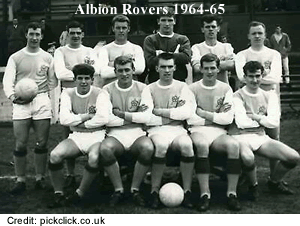 the kit's trim.
the kit's trim.
Some teams took a more radical approah. Coatbridge side, Albion Rovers had since their formation in 1882 worn plain blue but in 1961 their chairman, Tam Fagin, decided it was time to give the Wee Rovers a more distinctive look. His choice was for a primrose and white strip with red trim at the shorts and socks. While this unique outfit did not bring about any earth-shattering success it did mean the team were instantly recognisable. The strip would gradually evolve into a more simple combination of yellow and red that is worn to this day.
Historically, knickers were only available in white, navy or black but with the advent of nylon shorts, a wide range of 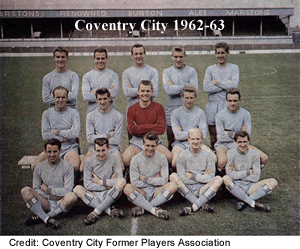 colours now became available, allowing teams to wear matching shirts and shorts. In 1962 Jimmy Hill, seeking to reinvigorate the under-achieving Coventry team launched his "Sky Blue Revolution" which included a smart all blue kit for the team.
The idea was taken up by Chelsea (1964), Liverpool (1964) Wolves (1965) and Aberdeen (1966)
setting a trend that led to many well-loved traditional designs disappearing in favour of matching plain shirts and shorts, sometimes with contrasting stockings. In the 1965-66 season 21 of the 92 members of the Football League were turning out in matched kits. While most later reverted to other designs, for Chelsea, Liverpool, Leeds United and Aberdeen the new look has since become iconic.
colours now became available, allowing teams to wear matching shirts and shorts. In 1962 Jimmy Hill, seeking to reinvigorate the under-achieving Coventry team launched his "Sky Blue Revolution" which included a smart all blue kit for the team.
The idea was taken up by Chelsea (1964), Liverpool (1964) Wolves (1965) and Aberdeen (1966)
setting a trend that led to many well-loved traditional designs disappearing in favour of matching plain shirts and shorts, sometimes with contrasting stockings. In the 1965-66 season 21 of the 92 members of the Football League were turning out in matched kits. While most later reverted to other designs, for Chelsea, Liverpool, Leeds United and Aberdeen the new look has since become iconic.
In 1964 Chelsea added numbers to their shorts for
the first 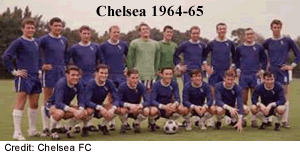 time, an innovation that proved popular and which would become compulsory some 30 years later.
time, an innovation that proved popular and which would become compulsory some 30 years later.
For the 1968-69 season Southend United switched from their mid-blue shirts to navy ones. Part way through the season they were instructed to change these because they were deemed to be too similar to 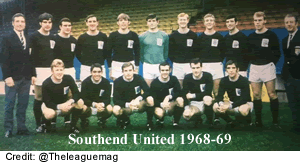 the black uniforms worn by referees. The club borrowed alternative shirts from various clubs before holding a supporters' poll which came out overwhelmingly in favour of West Bromwich Albion's striped tops with white sleeves (thus preserving the navy and white theme). Arsenal and Spurs both had to drop their own navy change tops in favour of yellow ones. No such concerns affected the Scottish Football League, where navy tops had been popular since the Victorian age and were, of course, the traditional colours of the national team. The SFA avoided the problem with the simple expedient of providing match officials with
the black uniforms worn by referees. The club borrowed alternative shirts from various clubs before holding a supporters' poll which came out overwhelmingly in favour of West Bromwich Albion's striped tops with white sleeves (thus preserving the navy and white theme). Arsenal and Spurs both had to drop their own navy change tops in favour of yellow ones. No such concerns affected the Scottish Football League, where navy tops had been popular since the Victorian age and were, of course, the traditional colours of the national team. The SFA avoided the problem with the simple expedient of providing match officials with 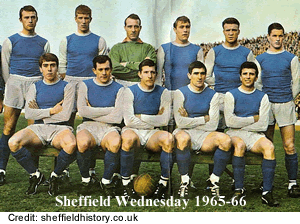 alternative red or yellow tops to be worn when necessary but such a radical idea cut no ice with English administrators.
alternative red or yellow tops to be worn when necessary but such a radical idea cut no ice with English administrators.
Also in 1968-69 visiting English teams were required to change their socks if these were deemed too similar to those of their opponents.
While the drive to modernise the look of teams during the decade resulted in a reduction in the variety of designs on view (in the 1967-68 season, for example, none of the Football League teams historically associated with blue and white striped shirts were wearing them). The most famous of these were Sheffield Wednesday, who 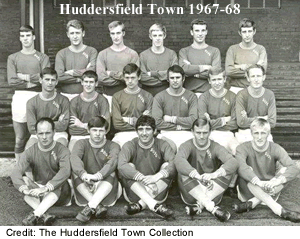 dropped the striped shirts they had worn since the late-nineteenth century in 1965 and Huddersfield Town who abandoned their own cherished stripes in 1966.
dropped the striped shirts they had worn since the late-nineteenth century in 1965 and Huddersfield Town who abandoned their own cherished stripes in 1966.
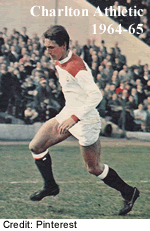 For the 1964-65 season Charlton Athletic opted to wear a predominantly white kit with a distinctive design feature in the form of a red shoulder flash. The newly designed "sword-in-hand" crest made its first appearance on this shirt. Coincidentally Middlesbough wore their own version of this top that season albeit with the colours reversed. "Boro could claim theirs was a revival of the strip they had worn between the wars.
For the 1964-65 season Charlton Athletic opted to wear a predominantly white kit with a distinctive design feature in the form of a red shoulder flash. The newly designed "sword-in-hand" crest made its first appearance on this shirt. Coincidentally Middlesbough wore their own version of this top that season albeit with the colours reversed. "Boro could claim theirs was a revival of the strip they had worn between the wars.
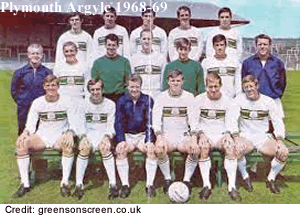 That same season, Plymouth Agyle also followed the trend for white kits, but their version featured attractive bands around the body as well as green, black and white trimmings throughout. The new "Mayflower" club crest was set in the centre to complete what is widely considered to be one of the most elegant strips ever created.
That same season, Plymouth Agyle also followed the trend for white kits, but their version featured attractive bands around the body as well as green, black and white trimmings throughout. The new "Mayflower" club crest was set in the centre to complete what is widely considered to be one of the most elegant strips ever created.
T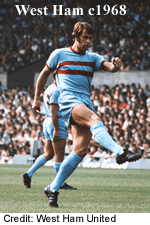 he West Ham United team of the mid-Sixties included three World Cup heroes, Moore, Peters and Hurst and their smart change strip was instantly recognisable whenever it appeared. The two-hoop design was also worn by Hull City, Peterborough United, Montrose and Raith Rovers while Dundee United had worn something similar as far back as 1958.
he West Ham United team of the mid-Sixties included three World Cup heroes, Moore, Peters and Hurst and their smart change strip was instantly recognisable whenever it appeared. The two-hoop design was also worn by Hull City, Peterborough United, Montrose and Raith Rovers while Dundee United had worn something similar as far back as 1958.
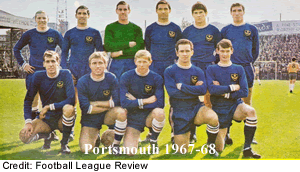 Since 1947, at the behest of their president Field Marshall Montgomery, Portsmouth had worn blue shirts, white shorts and red socks to honour the members of the armed forces who died during the Second World War. Twenty years on management decided it was time to
Since 1947, at the behest of their president Field Marshall Montgomery, Portsmouth had worn blue shirts, white shorts and red socks to honour the members of the armed forces who died during the Second World War. Twenty years on management decided it was time to 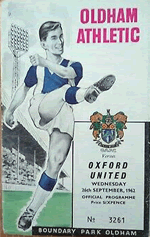 modernise and the team took the field in all blue with red, white and blue trimmings.
modernise and the team took the field in all blue with red, white and blue trimmings.
Oldham Athletic's traditional blue and white tops had first appeared in 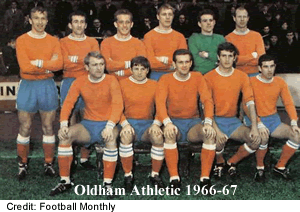 1919 and were by now looking very old fashioned indeed. The club decided on a complete make-over and opted for a garish tangerine and blue strip set off by blue and white trim on the shirt and stocking turn-overs. The new look lasted until 1972 when a more sober blue and white pallette was adopted.
1919 and were by now looking very old fashioned indeed. The club decided on a complete make-over and opted for a garish tangerine and blue strip set off by blue and white trim on the shirt and stocking turn-overs. The new look lasted until 1972 when a more sober blue and white pallette was adopted.
Norwich City also went for a more colourful look and switched 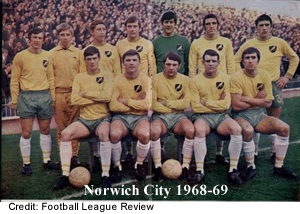 from their traditional black shorts to green ones in October 1965. Although black shorts
from their traditional black shorts to green ones in October 1965. Although black shorts 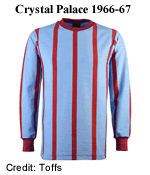 were reinstated a year later, green reappeared in 1967 and would become part of their signature strip a few years later.
were reinstated a year later, green reappeared in 1967 and would become part of their signature strip a few years later.
The popularity of candy-striped shirts in England was on the wane by the middle of the decade so when Crystal Palace adopted them in their signature claret and blue in 1966, they certainly caught the eye. The colours were reversed the following season and 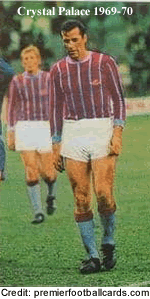 when they were promoted to the First Division in 1969, these smart tops were set off with the club name picked out in gold script on the left breast and gold trim at collar and cuff.
when they were promoted to the First Division in 1969, these smart tops were set off with the club name picked out in gold script on the left breast and gold trim at collar and cuff.
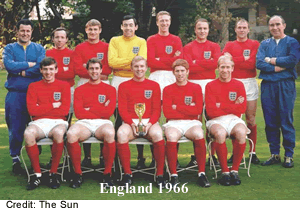 In June 1966, coached by Alf Ramsey, England won the World Cup at Wembley Stadium. The England kit of white shirts and dark blue shorts had evolved gradually over time according to the changing fashion of the period. By 1965 the classic white/dark blue/white combination was settled upon with a red/white red alternative, both set off by the cherished three-lions crest. The elegant, minimalist simplicity of these strips represent the epitome of Sixties cool.
In June 1966, coached by Alf Ramsey, England won the World Cup at Wembley Stadium. The England kit of white shirts and dark blue shorts had evolved gradually over time according to the changing fashion of the period. By 1965 the classic white/dark blue/white combination was settled upon with a red/white red alternative, both set off by the cherished three-lions crest. The elegant, minimalist simplicity of these strips represent the epitome of Sixties cool.
We cannot leave the decade without considering a typical piece of audacity from the flamboyant Scot, Tommy Docherty. Having established his reputation as a 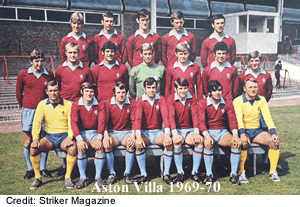 successful manager with Chelsea (1961-67) he had a brief spell with Rotherham United (relegated) and an even briefer one with Queen's Park Rangers (resigned after 29 days following a row with the chairman) before being appointed manager of Aston Villa in December 1968. In preparation for the 1969-70 season he introduced a radical redesign of Villa's treasured traditional strip. The contrasting blue sleeves, worn for more than 75 years were dropped and a novel flappy collar with v inset appeared. The claret shirts were now teamed with light blue shorts, the first time ever that such a combination had been tried. To cap it all the familar crest was gone, replaced by a somewhat scrawny lion rampant in light blue above the letters "AV" in an ornate script. Had the season gone well this might have entered the pantheon as a classic strip but in January 1970, Villa were bottom of The Second Division and "The Doc" was sacked. The board immediately made a request to the Football League management committee that they be allowed to switch back to their strip from the previous season, which was granted.
successful manager with Chelsea (1961-67) he had a brief spell with Rotherham United (relegated) and an even briefer one with Queen's Park Rangers (resigned after 29 days following a row with the chairman) before being appointed manager of Aston Villa in December 1968. In preparation for the 1969-70 season he introduced a radical redesign of Villa's treasured traditional strip. The contrasting blue sleeves, worn for more than 75 years were dropped and a novel flappy collar with v inset appeared. The claret shirts were now teamed with light blue shorts, the first time ever that such a combination had been tried. To cap it all the familar crest was gone, replaced by a somewhat scrawny lion rampant in light blue above the letters "AV" in an ornate script. Had the season gone well this might have entered the pantheon as a classic strip but in January 1970, Villa were bottom of The Second Division and "The Doc" was sacked. The board immediately made a request to the Football League management committee that they be allowed to switch back to their strip from the previous season, which was granted.
A footnote to this story is that while the flappy collars were at the time thought of as revolutionary, a very similar style had appeared in the previous decade and was still worn in Scotland by Hearts. Ironically, Docherty's novel kit may have been consigned to the bin but the flappy collar was about to take the world of football in the UK by storm.
© Dave Moor (2023)